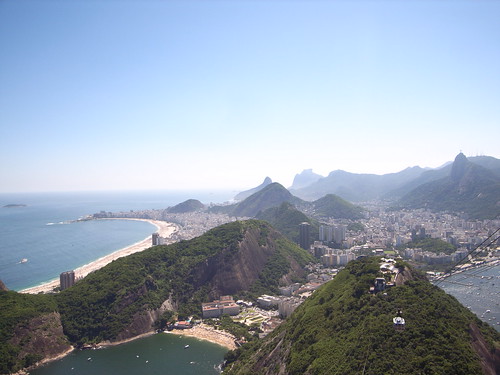Discovering new cities on continent where you've never been is always refreshing and intriguing. In Rio de Janeiro, I've tried to make few notes about spatiality. Nothing very professional (I'm not an urbanist) nor linked to my current research, it's rather my naive appraisal of space there. One of the first thing I've done there was to find a spot high enough to embrace the whole cityscape. It's definitely easier here since there lots of high-rise plus tourist spots such as the Corcovado or the Paõ de Açucar which allows to get views such as:
One can easily imagine on that picture how the city grew starting on the right and then spreading all over the place with only hills and the ocean as limits. Interestingly, there has been some attempts to fight against these boundaries: suppressing a hill on the right (where stands the cathedral), putting the material to extend the ground (and new beaches) or having informal buildings on hills (mostly favela areas).
The city appears to be very dense here but when you go to the south or much further from the ocean, it's then less high (still very dense) with favelas or low-rise buildings. Although streets and roads are quite big downtown, favelas do not have streets per se, it's rather corridors where no vehicle could get around (hence the presence of gang members who can secure their presence, less accessible to police forces). Rio is an interesting mix of very controlled urban planning (e.g. street grids very straights) and informal architectures (e.g. favelas).
At the street level, what struck me, especially in Ipanema, Copacobana, Leblon or Niteroi is the presence of a structure almost always based on the model below:
In a sense: street level have either shops or buildings with fences. Generally there are even two fences with digicodes and very often a guardian/janitor. No one seems to live at this level and the first story is also generally very high from the street. As a European, this gives the impression of living far enough from the street level: a sort of Ballardian architecture of control. In a way it's close to what Mike Davis would describe at the city level in LA (Bunker Hill separated form the rest of the city) except that here it's at a micro level: every building seems to maintain a certain distance between appartments and the street. Again, this is entirely different from old colonial one/two-stories buildings or favelas in which appartments spread everywhere there is enough room to put a blanket/mattress.

